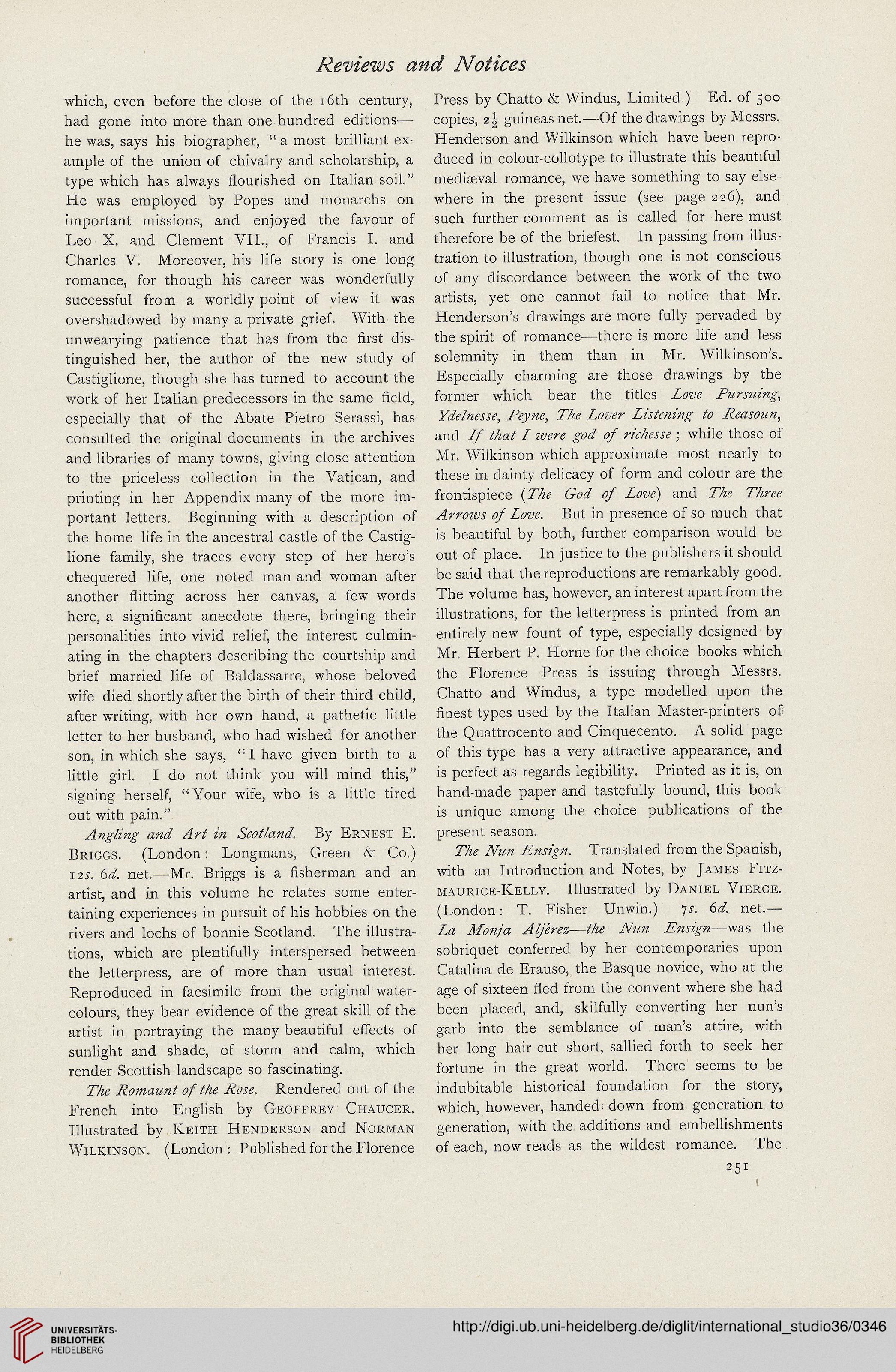which, even before the close of the 16th century,
had gone into more than one hundred editions—
he was, says his biographer, " a most briUiant ex-
ampie of the union of chivairy and schoiarship, a
type which has aiways dourished on Itaiian soil."
He was employed by Popes and monarchs on
important missions, and enjoyed the favour of
Leo X. and Ciement VII., of Francis I. and
Charies V. Moreover, his iife story is one iong
romance, for though his career was wonderfuiiy
successfui from a woridiy point of view it was
overshadowed by many a private grief. With the
unwearying patience that has from the first dis-
tinguished her, the author of the new study of
Castigiione, though she has turned to account the
work of her Itaiian predecessors in the same field,
especiaiiy that of the Abate Pietro Serassi, has
consuited the originai documents in the archives
and iibraries of many towns, giving close attention
to the priceiess coliection in the Vatican, and
printing in her Appendix many of the more im-
portant ietters. Beginning with a description of
the home iife in the ancestrai castle of the Castig-
iione famiiy, she traces every step of her hero's
chequered iife, one noted man and woman after
another fiitting across her canvas, a few words
here, a significant anecdote there, bringing their
personaiities into vivid reiief, the interest cuimin-
ating in the chapters describing the courtship and
brief married iife of Baidassarre, whose beioved
wife died shortiy after the birth of their third chiid,
after writing, with her own hand, a pathetic iittie
ietter to her husband, who had wished for another
son, in which she says, " I have given birth to a
iittie giri. I do not think you wiii mind this,"
signing herseif, "Your wife, who is a iittie tired
out with pain."
<Z7«f <47*? 777 &V//i377<f. By ERNEST E.
BRIGGS. (London: Longmans, Green & Co.)
12^. 6<f. net.—Mr. Briggs is a fisherman and an
artist, and in this voiume he reiates some enter-
taining experiences in pursuit of his hobbies on the
rivers and iochs of bonnie Scotiand. The iiiustra-
tions, which are plentifuhy interspersed between
the ietterpress, are of more than usual interest.
Reproduced in facsimile from the original water-
colours, they bear evidence of the great skiil of the
artist in portraying the many beautiful effects of
suniight and shade, of storm and caim, which
render Scottish iandscape so fascinating.
W<7777<zM77/ <?/V%g Rendered out of the
French into Engiish by GEOFFREY CnAUCER.
IHustrated by KEITH HENDERSON and NoRMAN
WiLmNSON. (London: PublishedfortheFiorence
Press by Chatto & Windus, Limited.) Ed. of goo
copies, 2^ guineasnet.—Of thedrawings by Messrs.
Henderson and Wiikinson which have been repro-
duced in coiour-coiiotype to iiiustrate this beauttful
mediseval romance, we have something to say else-
where in the present issue (see page 226), and
such further comment as is caiied for here must
therefore be of the briefest. In passing from iiius-
tration to iiiustration, though one is not conscious
of any discordance between the work of the two
artists, yet one cannot faii to notice that Mr.
Henderson's drawings are more fuliy pervaded by
the spirit of romance—there is more iife and less
solemnity in them than in Mr. Wiikinson's.
Especiaiiy charming are those drawings by the
former which bear the tities Zwc Z*z<7-.K77'7z^,
HiMw.W, V<T)W, Y%<? Z<W<?7* ZAMZZTZ^ j?<f<W<77<77,
and 7*%<c/ L ^«</ <7/* ; whiie those of
Mr. Wilkinson which approximate most nearly to
these in dainty delicacy of form and colour are the
frontispiece (Z%^ <?«</ <7/* Z<7w) and
H7-7-<7Wj' <7/* Zwc. But in presence of so much that
is beautiful by both, further comparison wouid be
out of place. In justice to the publishers it shouid
be said that thereproductions are remarkably good.
The voiume has, however, an interest apart from the
iiiustrations, for the letterpress is printed from an
entireiy new fount of type, especiaiiy designed by
Mr. Herbert P. Horne for the choice books which
the Fiorence Press is issuing through Messrs.
Chatto and Windus, a type modelied upon the
hnest types used by the Itaiian Master-printers of
the Quattrocento and Cinquecento. A soiid page
of this type has a very attractive appearance, and
is perfect as regards iegibiiity. Printed as it is, on
hand-made paper and tastefuily bound, this book
is unique among the choice publications of the
present season.
77<^ A7777 ZTzrzgzz. Transiated from theSpanish,
with an Introduction and Notes, by JAMES FiTZ-
MAURICE-KELLV. IHustrated by DANIEL VlERGE.
(London: T. Fisher Unwin.) /i. 6</. net.—
Z<7 Z/<777/'<2 H^7-M-W?277 ^77^77-was the
sobriquet conferred by her contemporaries upon
Cataiina de Erauso, the Basque novice, who at the
age of sixteen Hed from the convent where she had
been piaced, and, skilfuliy converting her nun's
garb into the semblance of man's attire, with
her iong hair cut short, saliied forth to seek her
fortune in the great world. There seems to be
indubitabie historical foundation for the story,
which, however, handed down from generation to
generation, with the additions and embeilishments
of each, now reads as the wildest romance. The
251





